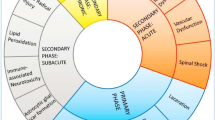Abstract
We have previously reported that ischemic spinal cord injury in rats leads to chronic pain-related behaviors. Thus, rats exhibited aversive reactions to innocuous mechanical stimuli (mechanical allodynia) applied to a body area at or rostral to the dermatomes innervated by the injured spinal segments. The responses of the rats to cold are also markedly enhanced (cold allodynia). Interestingly, more than 50% of spinally injured rats did not develop these abnormal pain-related behaviors after spinal cord injury. In the present study, we showed that the extent of injury is similar between allodynic and nonallodynic rats. Furthermore, intrathecal (i.t.) naloxone, a broad-spectrum opioid receptor antagonist, reversibly provoked mechanical and cold allodynia-like responses in spinally injured rats that did not develop such behaviors spontaneously. However, naloxone did not elicit such reactions in normal rats and did not alter the tail-flick latency in normal or spinally injured rats. Furthermore, i.t. d-Phe-Cys-Tyr-d-Trp-Orn-Thr-Pen-Thr-NH2 (CTOP) or naltridole, selective antagonists of μ and δ opioid receptors, respectively, also triggered pain-related behaviors similarly to naloxone. Although norbinaltorphimine (nor-BIN), a selective κ-receptor antagonist, also elicited such responses, the time course of the effect makes it unlikely that spinal κ-receptors were involved. These results suggested that the expression of abnormal pain-related behaviors in some spinally injured rats is tonically suppressed by the spinal opioidergic system. Interindividual differences that lead to lack or dysfunction of such inhibition may underly the appearence of pain-related behavior in some, but not all, spinally injured rats. It is suggested that such inhibition is exerted through spinal μ and δ, but not κ, opioid receptors. The endogenous opioidergic control appears to be only active against abnormal pain-related behaviors in spinally injured rats. Our results are relevant for the clinical observation that only a subgroup of patients with nerve injury suffers from neuropathic pain.
Similar content being viewed by others
Author information
Authors and Affiliations
Additional information
Received: 30 March 1997 / Accepted: 7 July 1997
Rights and permissions
About this article
Cite this article
Hao, JX., Yu, W. & Xu, XJ. Evidence that spinal endogenous opioidergic systems control the expression of chronic pain-related behaviors in spinally injured rats. Exp Brain Res 118, 259–268 (1998). https://doi.org/10.1007/s002210050280
Issue Date:
DOI: https://doi.org/10.1007/s002210050280



